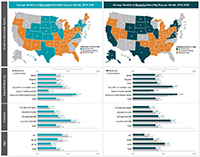Average number of days during the past 30 days when an adult's physical health or mental health was not good
Measure Overview
A variety of factors and circumstances can adversely affect an individual’s mental, emotional, and physical wellbeing on a day-to-day basis, such as lack of sleep, a stressful work environment, or poor diet. The number of days that an individual does not have good health–or “unhealthy days”–on a regular basis is one way to measure quality of life and can serve as a starting point for examining underlying health-related issues. Tracking unhealthy days across states and demographic groups is an essential component in identifying health disparities and formulating strategies to address these disparities and achieve equity.
Generate customized graphics using this data by selecting one of the options below.
Related Products

Measuring State-level Disparities in Unhealthy Days
These state fact sheets present a comparative analysis of adult physical and mental unhealthy days at the national level, state level, and across three demographic breakdowns: age, income, and race/ethnicity.

Exploring Disparities Using State Health Compare
This 2019 webinar hosted by SHADAC introduces two measures available on SHADAC’s State Health Compare web tool, Unhealthy Days and Unaffordable Rents, and examines how these measures can be used to explore disparities between states and among sub-populations.
